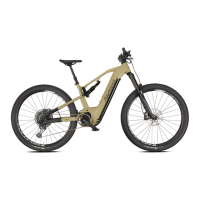12
Security
ORIGINAL INSTRUCTIONS | ADVANCED | 01.2022 | 1002021-01
Possible examples of improper use are:
• Manipulation or modification of the e-drive (tuning).
• Impermissible use with child seat and/or bicycle trailer
(e.g. child or cargo trailer).
2.3 Residual risks
Certain risks remain when using the e-bike, but can be redu-
ced by following the safety and warning instructions.
These usually include:
• Unpredictable driving manoeuvres and/or misbehaviour
of other road users;
• Surprising or sudden changes in the characteristics of
the road surface, e.g. freezing wetness or "black ice";
• Incalculable material defects or signs of wear/resulting
breakage or functional impairment of components.
2.4 Safety instructions
To reduce the general risk of accidents and injuries when
riding an e-bike:
f Do not use the e-bike until you are familiar with its
handling and function.
f Observe the intended use.
f Drive with foresight.
f Adjust driving style/speed to the current weather
conditions and road characteristics.
f On slippery, wet, slippery or dirty roads, allow for longer
braking distance/reduced tyre grip.
f Show consideration for other road users/drive defensi-
vely.
f Check the e-bike before each use (visual inspection).
Pay attention to, among other things: Cracks, grooves,
damage or colour changes on components.
f Always ensure that safety-relevant devices (e.g. brakes)
are correctly adjusted and in working order. Do not use
the e-bike if safety-relevant components are damaged
or do not function properly.
f Never replace components on the e-bike or make
modifications or repairs yourself.
Damage to the e-bike should always be repaired by the
bicycle dealer, and damaged components should
always be replaced with suitable original spare parts.

